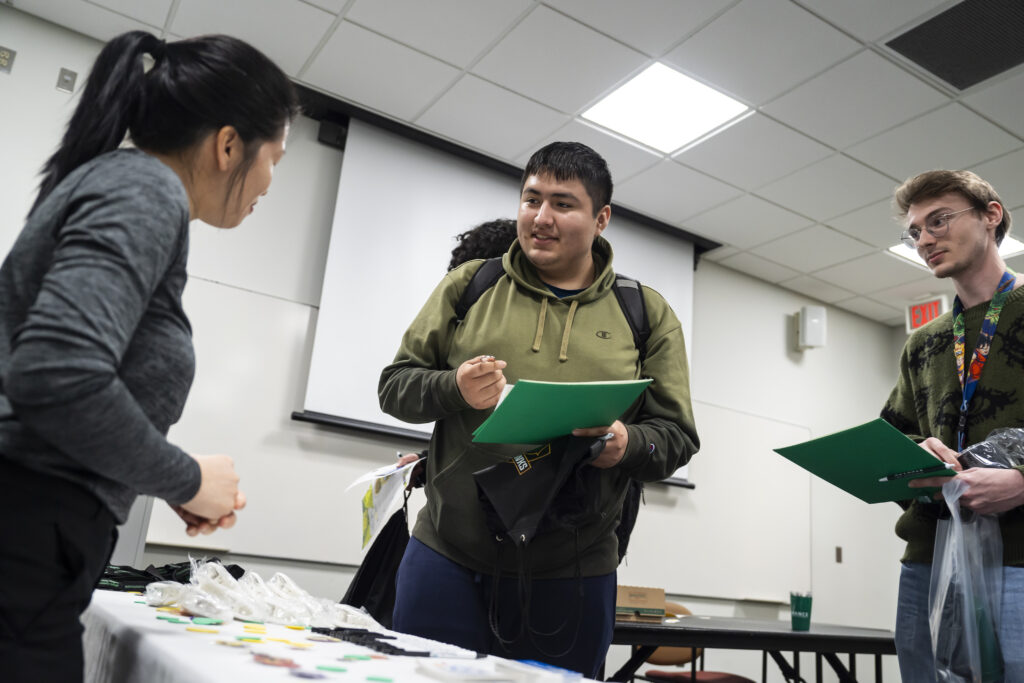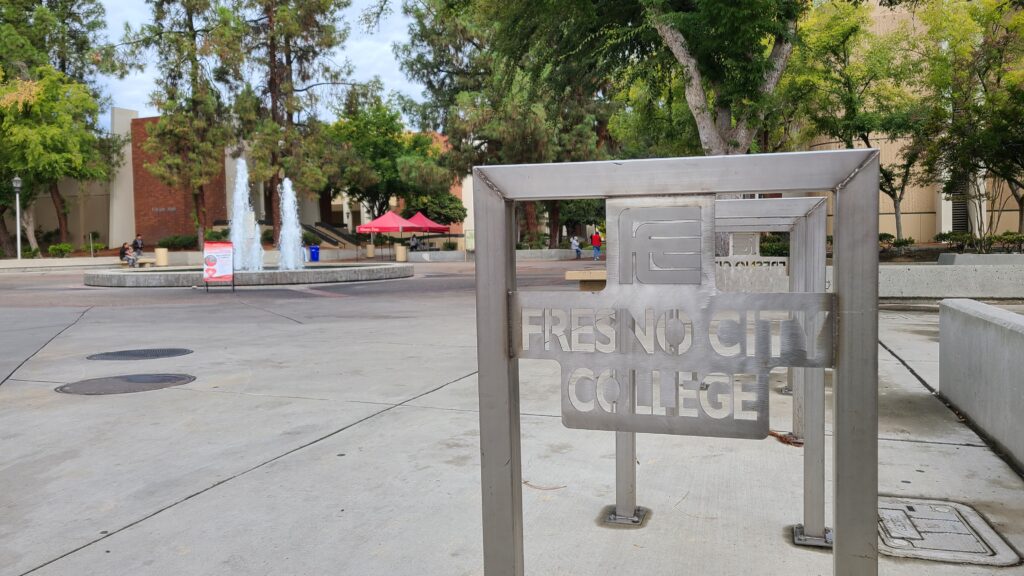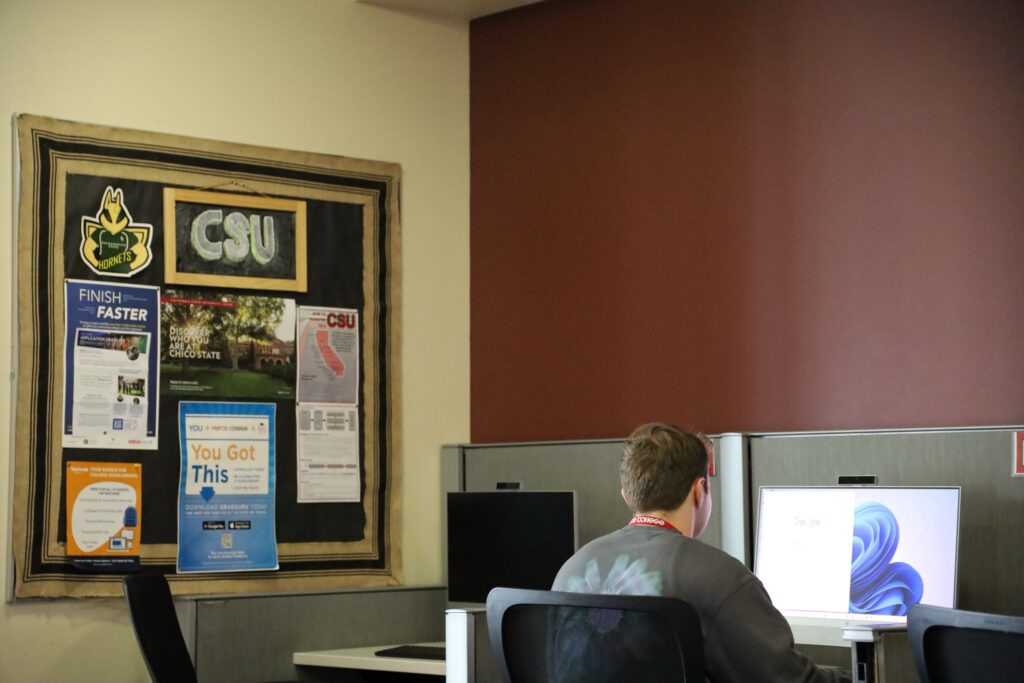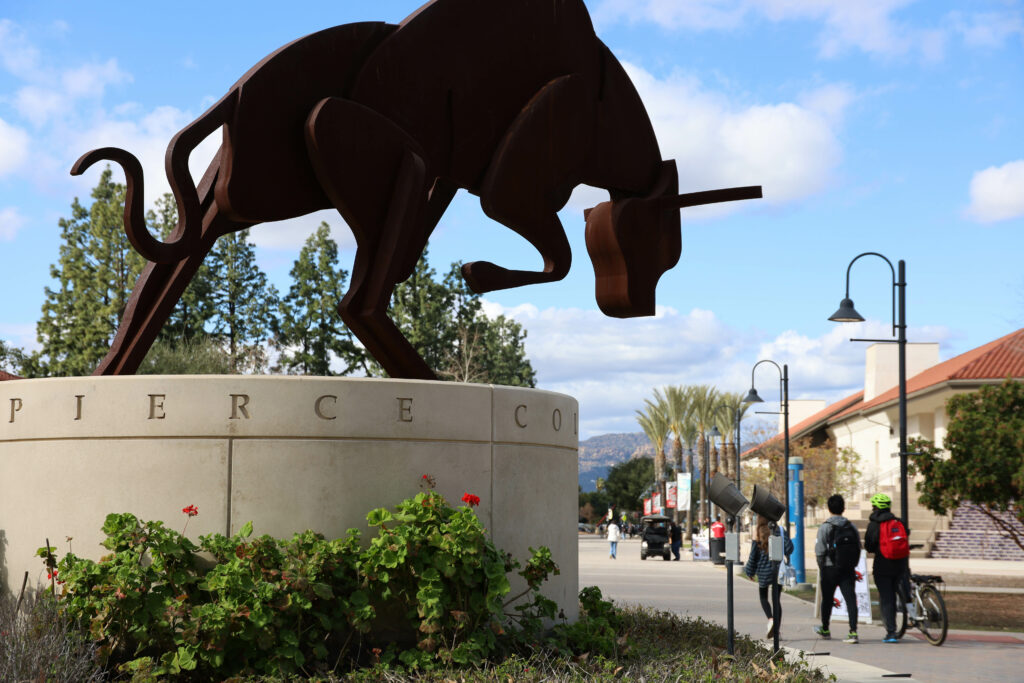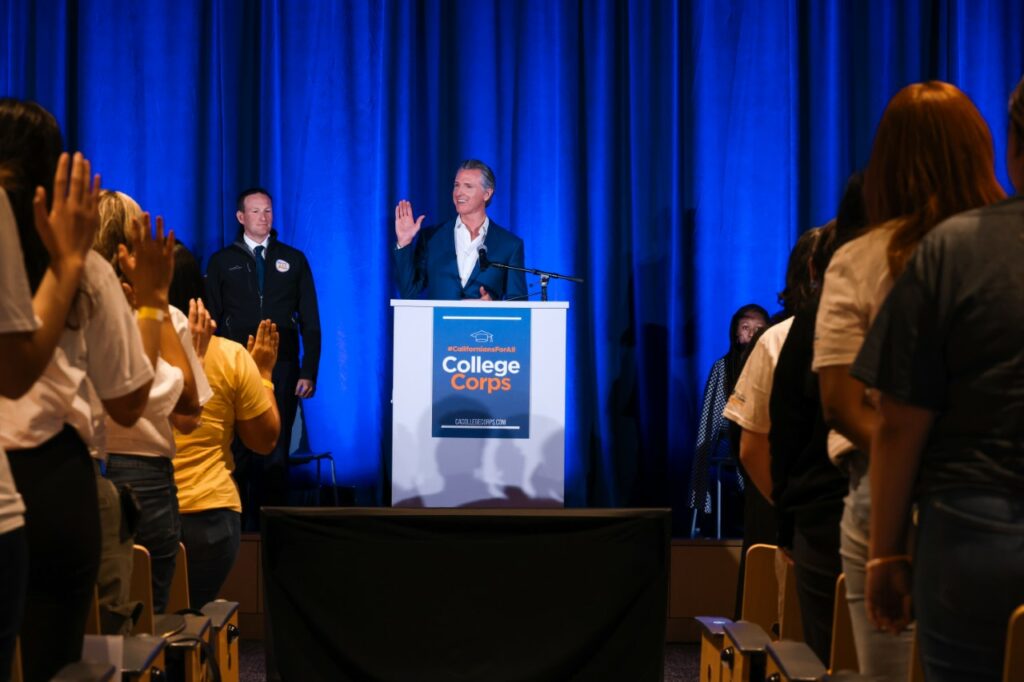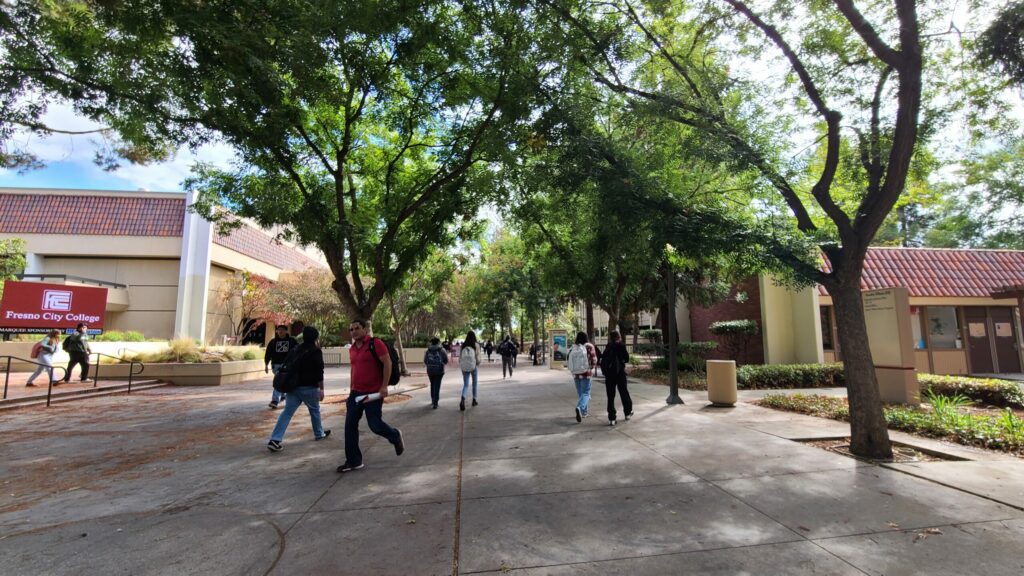
Steve Perez chats with a representative at the Northern Virginia Community College Office of Wellness and Mental Health resource table during the ADVANCE program welcome event at George Mason University on Jan. 31.
Credit: Taneen Momeni / EdSource
Steve Perez faced a daunting challenge as he considered where to attend college.
The first in his family to pursue a higher education, Perez was “basically all on my own.” Rejected from his top choice, Virginia Tech, he was considering community college near his hometown of Falls Church, Virginia. But he worried whether he would be able to successfully transfer to a four-year university, knowing it would be up to him to take the right courses and successfully apply for admission.

“No one in my family really knows anything about college,” he said. “That was really tough.”
All of that changed when his high school counselor told him about ADVANCE, a partnership between Northern Virginia Community College and George Mason University that is anchored by dual admission to both schools.
Students start at the community college but are immediately accepted to George Mason before even taking their first community college class. The colleges also provide students up front with the full list of courses they need to earn their bachelor’s degree, a task that in other states is often left to students.
Northern Virginia Community College serves about 70,000 students across its six campuses in the suburbs of Washington, D.C., more than any other community college in the state. Likewise, George Mason is the largest public research university in Virginia with about 40,000 students, most of them commuters. Their main campuses separated by just 5 miles, Northern Virginia historically has sent more students to George Mason than any other community college.

Officials say the ADVANCE program perfected that transfer partnership. Since launching in 2018, just over 1,500 students in the program have successfully transferred to Mason, including 415 this past fall. More than 90% of students in the program graduate within two years of transferring to Mason.
The program stands out nationally, even earning kudos from the federal Department of Education for solving a widespread problem of a cumbersome transfer process that stymies students in community college.
In California, most community college students who want to get a bachelor’s degree never transfer. Without adequate support, they often struggle to keep track of courses, ending up with too many credits but lacking required classes. One study found that as few as 2.5% of students intending to transfer do so within two years, and only 23% do so within four years.
The Virginia program could serve as a model for California colleges. The state is in the early stages of adopting its own dual admission programs at both of its public university systems, the University of California and California State University. CSU’s program, open to far more students than UC’s, is especially exciting to college access advocates.
Both programs launched this past fall, and officials are hopeful it will make transferring easier for students.
Taking away the guesswork
In Virginia, the idea of ADVANCE is to “take away the guesswork for students,” said Jen Nelson, the community college’s director of university transfer and initiatives.
Upon enrolling, students receive a link to a portal where they select one of 85 academic pathways, such as business, computer science or psychology. Based on their pathway, the portal then shows them all the classes they need to take to transfer and eventually earn a bachelor’s degree.
“It provides that guarantee that if students take these classes, they’re going to transfer,” Nelson said. “It takes away that concern of, am I taking the right thing? Am I spending my time and money in the right way?”
As long as they maintain at least a minimum grade point average — usually a 2.5 — students are automatically admitted to Mason. They don’t even need to fill out an application.
Along the way, students can meet with counselors who are hired specifically for the ADVANCE program. They also have full access to all the resources offered at Mason, including clubs, libraries and even health care.
In Perez’s case, he chose a computer science pathway and this semester started his lower-division classes, which include general education, math and introductory computer science classes. He’s on track to transfer to George Mason within two years.
At a recent resource fair for new students hosted on the Mason campus, Perez walked from table to table, learning about the resources offered by Mason, including club sports, mental health services and tutoring. He can participate in all of it now that he’s in the program.

“I’m really happy I chose this pathway because it gives me a great opportunity,” he said. “And it takes away the stress.”
Not long before ADVANCE launched in 2018, Janette Muir remembers sitting in on an advising session at Northern Virginia for her son, who had recently graduated from high school.
Muir, a professor and George Mason’s associate provost for academic initiatives at the time, was shocked to learn how confusing the transfer process was.
Students received little guidance, and many were taking unnecessary courses.
“I thought, ‘Oh my gosh, it’s so confusing for even a student who has professors as his parents,’” she said.
Her son and other students, Muir said, needed more help. Muir started working with the presidents of both institutions to develop ADVANCE.

That year, the two colleges launched the program with 21 pathways. It has since grown to 85 pathways, and more than 4,500 students have enrolled since the program’s inception.
Any student can enroll so long as they have not completed more than 30 college credits, and students who do enroll tend to stick around. Among the students in the cohort that entered in fall 2021, 87% returned the following year, far better than the national average retention rate of 61%.
When they transfer to Mason, ADVANCE students on average graduate two semesters faster than non-ADVANCE transfer students. In fact, 92% of them graduate within two years of transferring. Students also finish an associate degree upon transferring, which officials say is important to ensure they have the necessary preparation in their major.
Muir, who now oversees ADVANCE in her role as Mason’s vice provost for academic affairs, said officials have started to expect students to finish the entire program in four years rather than six.
“When you come into this program and you follow the pathways, you do better and you finish sooner,” Muir told new students gathered at a welcome event in January.
For Jaden Todd, a second-year community college student in the program, having access to the pathways portal has been especially helpful.
When Todd first started college, learning certain classes would transfer to some universities but not others was a “big shocker.” He took a Western history class only to learn that it wouldn’t be accepted at another college he was considering, Virginia Commonwealth University, which required a world history course.
“There’s stuff like that where I spent several hundred dollars on a class just to be informed that I would have to retake a class in a similar area,” he said.
When it comes to the courses he needs to transfer to and ultimately graduate from Mason, however, there are no surprises.
If students do have questions, they have access to counselors who have been hired specifically for the ADVANCE program.
Emma Howard, a sophomore who will transfer to Mason this fall, consulted her adviser after learning that one of her courses, which she thought qualified as an elective, wasn’t going to be transferable.
The adviser called the transfer center at Mason and successfully convinced them to count the course, an acting for the camera class.
“They really try to make your time here easier,” Howard said. “They bring a lot of ease and just faith in the matriculation process.”
Eliminating the ‘transfer shock’
When Maria Fruchterman transferred this past fall to Mason, she already had a close circle of friends. That’s because, while she was taking her lower-division community college classes, she was also playing club field hockey at Mason. It was a perk afforded to her because she was in the ADVANCE program.
“It’s been really good for my transition,” Fruchterman said. “I just felt at ease and very comfortable.”

The motivation to give Northern Virginia students access to the Mason campus was two-fold, Nelson said. For one, as a community college, Northern Virginia doesn’t offer all the same benefits and resources available at Mason and other four-year institutions, like health insurance and mental health counseling.
Officials also wanted to eliminate the “transfer shock” that transfer students often deal with upon arriving at the four-year university, Nelson said. “They’re going to a new environment. Everything is different,” she added.
By giving students access to those resources up front, it allows them to “hit the ground running,” Nelson said.
That’s what Perez is planning for himself. While visiting Mason’s main Fairfax campus for the welcome event, he felt a different buzz than what he was accustomed to at Northern Virginia’s main campus in nearby Annandale.
“I noticed that there’s so many more people around,” he said. “Especially in Annandale, it seems like everyone leaves campus by 3 p.m.”
As he learned about the different clubs offered at Mason, Perez said he planned to join several: a computer science club, a chess club, maybe even an intramural badminton team.
Can California replicate?
Whether California’s dual admission programs will significantly improve transfer won’t be known for some time. Both programs are in their infancy, just launched last fall.
Between the two, CSU may have a better chance at success, with a far more robust program than what UC offers. About 2,000 students enrolled in CSU’s first cohort, compared to just 182 for UC.
CSU’s program is open to essentially any first-time college freshman entering a California community college. Students can enroll by creating an account on the CSU Transfer Planner portal and selecting from one of the degree programs across CSU’s 23 campuses. Eligible students are guaranteed admission.
UC’s program is limited only to students who applied to UC but weren’t eligible because they didn’t complete their A-G course requirements in high school. That was the minimum required by a state law passed in 2021 creating the dual admission programs.
The law, designed to give students a second chance at attending UC or CSU, asks UC and requires CSU to offer dual admission to students who didn’t “meet freshman admissions eligibility criteria due to limitations in the high school curriculum offered or personal or financial hardship.” CSU’s program goes beyond what’s required by law by offering dual admission to just about any student who was rejected or simply chose not to attend CSU.
UC may be less incentivized to admit students because several campuses have capacity issues and turn away many qualified applicants each year. UC’s program is limited to only six of its nine undergraduate campuses, with its three most exclusive campuses — Berkeley, Los Angeles and San Diego — not included.
CSU’s dual admission program is available at every campus, though select programs with capacity issues are excluded, such as some engineering programs at Cal Poly San Luis Obispo.
CSU officials hope the dual admission program will eliminate a problem with the current system: local campuses and their staff aren’t familiar with prospective transfer students until they apply.
“We want this to be an opportunity for us to connect with them way earlier in the process and support them,” said April Grommo, CSU’s assistant vice chancellor of enrollment management.
Similar to the Virginia program, students on CSU’s dual admission pathway get access to an online transfer planner showing them all the classes they need upfront.
Hans Johnson, a senior fellow at the Public Policy Institute of California’s higher education center, is hopeful it will make a meaningful difference. In an August 2023 PPIC report, Johnson and other researchers identified dual admission as a “promising approach” to help solve California’s transfer dilemma.
“A lot of the challenge for community college students when they start is knowing what is required to get into UC and CSU,” he said. “By front loading all of that information, we think students would face fewer obstacles and be more efficient.”
In addition, CSU’s dual admission program gives community college students access to programs and services available at the campus closest to their residence, like the ADVANCE program does. One CSU campus, Long Beach, for years has already been offering something similar. As part of the “Long Beach Promise 2.0,” launched in 2018, students at nearby Long Beach City College have the option to receive a “future student” ID card for CSU Long Beach and can access the campus library, athletic events, clubs and more.
“A lot of research in higher education focused on why students complete or why they don’t complete has included this notion of belonging, feeling a part of the campus,” Johnson said. “And I think the more that you can do for community college students can only help that sense of belonging so that when you eventually do transfer, you feel like it’s your school.”
In Virginia, staff at George Mason and the community college are often asked how other colleges can replicate their success.

Officials at those colleges point out that the two institutions have several factors working in their favor. The partnership is natural given the geographic proximity and historical relationship between the colleges. There are a number of faculty who have taught at both colleges. The colleges’ presidents work closely and actually spend time with each other, like meeting up for an occasional breakfast.
“How do you do this work? I can tell you it’s not easy. If it was easy, lots of people would be doing it,” Muir said. “It takes a lot of relationship-building, a lot of connection and recognizing the value of a community college education.”
